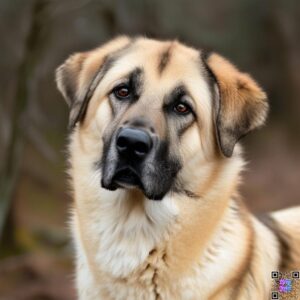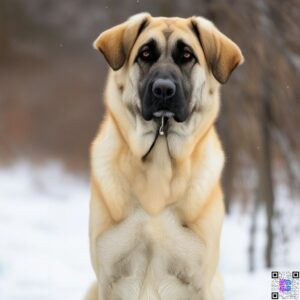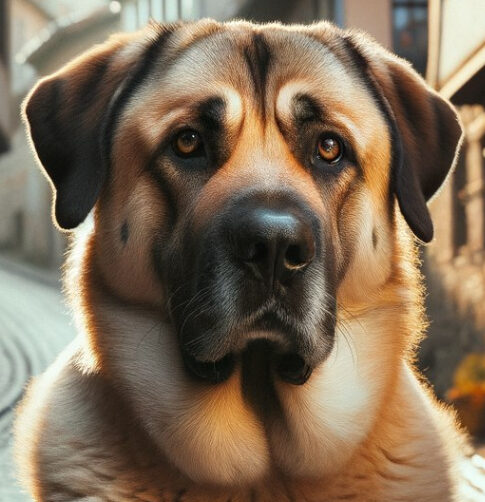Introduction
The sable Anatolian shepherd is a majestic and ancient breed that has been guarding flocks and families in Turkey for centuries. Known for their loyalty, protectiveness, and gentle nature, these large and powerful dogs make excellent livestock guardians and devoted companions. In this comprehensive guide, we will explore the history, physical characteristics, temperament, and care requirements of the sable Anatolian shepherd, as well as their role as both a working dog and a family pet.
History and Origins of the Sable Anatolian Shepherd

The Anatolian shepherd dog, also known as the Kangal shepherd dog, has its roots in the Anatolia region of Turkey. These dogs have been used for over a millennium to protect sheep and goats from predators while grazing. The breed’s development has been influenced by various ancient civilizations and migrations in the region, resulting in a hardy and adaptable dog well-suited for the harsh climate and terrain of Turkey.
Sable Anatolian Shepherd: An Overview
The Sable Anatolian Shepherd is part of a larger lineage that includes various colors and patterns, but its sable coat is particularly striking. These dogs are typically large and muscular, standing between 27 to 29 inches tall at the shoulder. Weighing anywhere from 80 to 150 pounds, they possess a commanding presence. Their coats can vary in color from fawn to brindle, but the sable variant stands out with its rich golden-brown hue accented by darker markings.This breed is primarily known as a livestock guardian dog. They have been bred to protect flocks from predators such as wolves and bears. Their natural instincts make them excellent watchdogs, alerting their owners to any potential threats. However, their protective nature also means they require proper training and socialization from a young age to ensure they are well-adjusted companions.
Physical Characteristics of the Sable Anatolian Shepherd
Coat Color and Texture
The sable Anatolian shepherd typically has a short, dense double coat that can range from fawn to sable in color. The undercoat is soft and insulating, while the outer coat is coarse and weather-resistant. Sable Anatolian shepherds may also have white markings on their face, chest, and legs.
Size and Build
Anatolian shepherds are large and muscular dogs, with males typically standing between 29 and 32 inches tall at the shoulder and weighing between 110 and 150 pounds. Females are slightly smaller, ranging from 27 to 29 inches tall and 80 to 120 pounds. Despite their size, Anatolian shepherds are agile and athletic, with a sturdy build that allows them to move quickly and easily over rough terrain.
Facial Features
The sable Anatolian shepherd has a large, broad head with a strong muzzle and a black nose. Their eyes are almond-shaped and typically dark brown, while their ears are small and triangular, often dropping to the side of the head. The breed’s tail is thick and bushy, often curling up towards the back.
Temperament and Personality of the Sable Anatolian Shepherd
Loyalty and Protectiveness
Sable Anatolian shepherds are fiercely loyal to their families and extremely protective of their flock or property. They are alert and vigilant, quick to bark or physically intervene if they perceive a threat. These dogs have a strong guarding instinct and will not hesitate to confront predators or intruders.
Gentleness with Family
Despite their imposing size and protective nature, sable Anatolian shepherds are gentle and affectionate with their family members, especially children. They are patient and tolerant, often forming strong bonds with the people they live with. However, it’s essential to supervise interactions between Anatolian shepherds and young children to ensure everyone’s safety.
Independence and Stubbornness
Anatolian shepherds are independent thinkers and can be stubborn at times. They require patient and consistent training from an early age to develop good manners and obedience. These dogs respond best to positive reinforcement methods and may not respond well to harsh or punitive training techniques.
Grooming and Care Requirements for the Sable Anatolian Shepherd
Brushing and Shedding
Sable Anatolian shepherds have a double coat that sheds heavily, especially during seasonal changes. Regular brushing, at least twice a week, is necessary to remove loose hair and prevent matting. During heavy shedding periods, daily brushing may be required to keep the coat looking its best.
Bathing and Nail Trimming
Anatolian shepherds should be bathed only when necessary, as over-bathing can strip the natural oils from their coat and skin. Nail trimming should be done regularly to prevent overgrowth and discomfort. It’s essential to introduce these grooming practices to puppies early on to make them more comfortable with the process.
Ear and Teeth Care
Checking and cleaning the ears regularly is crucial for preventing ear infections in Anatolian shepherds. Their ears should be inspected weekly and cleaned as needed. Dental care is also important, as these dogs are prone to tartar buildup and gum disease. Regular teeth brushing and dental check-ups can help maintain good oral health.
Health Considerations for the Sable Anatolian Shepherd
Common Health Issues
Sable Anatolian shepherds are generally healthy dogs, but like all breeds, they are susceptible to certain health conditions. Some common issues include hip and elbow dysplasia, thyroid disorders, and gastric torsion (bloat). Responsible breeders screen for these conditions and work to minimize the risk in their breeding programs.
Lifespan
The average lifespan of a sable Anatolian shepherd is 10 to 15 years, which is typical for a large breed dog. Providing a healthy diet, regular exercise, and proper veterinary care can help extend their lifespan and improve their quality of life.
Veterinary Care
Regular veterinary check-ups, vaccinations, and preventive care are essential for maintaining the health and well-being of sable Anatolian shepherds. These dogs should be seen by a veterinarian at least once a year for a comprehensive physical exam and any necessary tests or treatments.
Training and Exercise Needs of the Sable Anatolian Shepherd
Socialization and Obedience Training
Early socialization and obedience training are crucial for sable Anatolian shepherds. These dogs need to be exposed to a variety of people, animals, and environments from a young age to prevent fear-based aggression and develop good manners. Positive reinforcement training methods, such as treats and praise, are most effective for this breed.
Exercise Requirements
Anatolian shepherds are active dogs that require regular exercise to maintain their physical and mental well-being. They should be taken on daily walks or hikes and given opportunities to run and play in a secure, fenced area. These dogs also enjoy activities like swimming and agility training, which can provide both physical and mental stimulation.
Mental Stimulation
In addition to physical exercise, sable Anatolian shepherds need mental stimulation to prevent boredom and problem behaviors. Providing puzzle toys, training games, and interactive playtime can help keep their minds active and engaged. These dogs also enjoy having a job or purpose, such as guarding livestock or participating in obedience or herding trials.
The Sable Anatolian Shepherd as a Livestock Guardian
Herding and Flock Protection
The sable Anatolian shepherd’s primary purpose is to guard livestock, particularly sheep and goats, from predators. These dogs have a strong herding instinct and will naturally gather and protect their flock. They are patient and gentle with the animals they guard, rarely harming them even when hungry.
Guarding Instincts
Anatolian shepherds are highly attuned to potential threats and will bark or physically confront predators to protect their flock. They have a keen sense of their territory and will patrol the area to ensure the safety of their charges. These dogs are not aggressive by nature but will not hesitate to use force if necessary to defend their flock or property.
Territorial Behavior
Sable Anatolian shepherds are very territorial and will mark their boundaries to establish their claim. They are often suspicious of strangers and may be wary of unfamiliar people or animals entering their territory. Proper socialization and training can help manage this territorial behavior and prevent it from becoming problematic.
The Sable Anatolian Shepherd as a Family Companion
Bonding with Owners
When raised as a family pet, sable Anatolian shepherds form strong bonds with their owners and are very affectionate and loyal. They thrive on human companionship and enjoy spending time with their family members. These dogs are often referred to as “velcro dogs” due to their tendency to follow their owners around and seek out physical contact.
Interaction with Children
Anatolian shepherds are generally good with children, especially if they have been properly socialized and trained. However, it’s essential to supervise interactions between these large dogs and young children to prevent accidental injuries. Teach children how to interact with the dog safely and never leave them alone together.
Living with Other Pets
Sable Anatolian shepherds can live peacefully with other pets, especially if they have been introduced and socialized from a young age. However, their strong prey drive may cause them to chase or harass smaller animals, such as cats or rodents. It’s essential to monitor interactions between Anatolian shepherds and other pets and provide separate resources, such as food and toys, to prevent conflicts.
Sable Anatolian Shepherd Breeders and Adoption
Finding a Reputable Breeder
When looking for a sable Anatolian shepherd puppy, it’s essential to find a reputable breeder who prioritizes the health, temperament, and welfare of their dogs. A good breeder will screen for genetic health conditions, socialize their puppies from an early age, and be available to answer questions and provide support after the sale.
Adopting from Shelters or Rescues
Anatolian shepherds occasionally end up in shelters or rescue organizations due to owner surrender or neglect. Adopting an Anatolian shepherd can be a rewarding experience, but it’s essential to be prepared for the challenges that may come with a rescue dog. These dogs may have behavioral or health issues that require patience, training, and veterinary care.
Puppy Socialization and Training
Whether you purchase a puppy from a breeder or adopt an Anatolian shepherd, it’s crucial to start socialization and training as early as possible. Puppies should be exposed to a variety of people, animals, and environments to prevent fear-based aggression and develop good manners. Positive reinforcement training methods, such as treats and praise, are most effective for this breed.
Despite being an ancient breed steeped in history, several myths surround the Sable Anatolian Shepherd that deserve clarification:
- Myth: They’re aggressive towards people: While protective by nature, proper training ensures they are friendly towards family members.
- Myth: They don’t need much exercise: In reality, these dogs thrive on regular physical activity due to their working background.
- Myth: They’re unsuitable as family pets: With proper socialization from puppyhood onward—and understanding family dynamics—they can be wonderful companions.

FAQs
-
Are sable Anatolian shepherds good family dogs?
-
How much exercise do Anatolian shepherds need?
-
Are Anatolian shepherds easy to train?
-
What health problems are common in Anatolian shepherds?
-
How much do Anatolian shepherd puppies cost?
-
Can Anatolian shepherds be left alone?
Conclusion
The sable Anatolian shepherd is a majestic and ancient breed that has been guarding flocks and families in Turkey for centuries. Known for their loyalty, protectiveness, and gentle nature, these large and powerful dogs make excellent livestock guardians and devoted companions. With proper socialization, training, and care, sable Anatolian shepherds can thrive in a variety of living situations and provide their owners with years of love and companionship.
